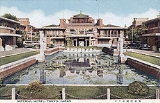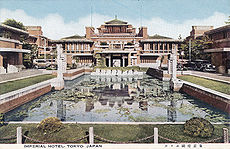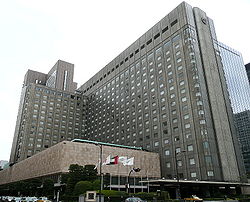
Imperial Hotel, Tokyo
Encyclopedia

Hibiya Park
is a park in Chiyoda City, Tokyo, Japan. It covers an area of 161,636.66m2 between the east gardens of the Imperial Palace to the north, the Shinbashi district to the southeast and the Kasumigaseki government district to the west....
, and the Ginza
Ginza
is a district of Chūō, Tokyo, located south of Yaesu and Kyōbashi, west of Tsukiji, east of Yūrakuchō and Uchisaiwaichō, and north of Shinbashi.It is known as an upscale area of Tokyo with numerous department stores, boutiques, restaurants and coffeehouses. Ginza is recognized as one of the most...
neighborhood. Three buildings have stood on the hotel site, each of which embodied the finest western design of their era.
First Imperial Hotel 1890-1919
The original Imperial Hotel in Tokyo was completed in 1890, backed by key Japanese leaders, such as Foreign Minister Count Kaoru Inoue and Viscount Eiichi ShibusawaEiichi Shibusawa
' was a Japanese industrialist widely known today as the "father of Japanese capitalism". He spearheaded the introduction of Western capitalism to Japan after the Meiji Restoration. He introduced many reforms including use of double entry accounting, joint stock corporations and modern note-issuing...
. Architect Yuzuru Watanabe designed the hotel, known as "Watanabe House", in the German neo-Renaissance style. French cuisine was the official banquet fare of the Imperial Palace, and the Imperial Hotel followed that tradition. By 1917, the hotel was no longer able to accommodate the growing number of visitors, and the design was seen as outdated. To replace the original wooden structure, the owners commissioned a design by Frank Lloyd Wright
Frank Lloyd Wright
Frank Lloyd Wright was an American architect, interior designer, writer and educator, who designed more than 1,000 structures and completed 500 works. Wright believed in designing structures which were in harmony with humanity and its environment, a philosophy he called organic architecture...
. Watanabe's Imperial Hotel burned down in 1919.
Second Imperial Hotel 1923-1968

Frank Lloyd Wright
Frank Lloyd Wright was an American architect, interior designer, writer and educator, who designed more than 1,000 structures and completed 500 works. Wright believed in designing structures which were in harmony with humanity and its environment, a philosophy he called organic architecture...
's buildings in Japan. It was designed roughly in the shape of its own logo, with the guest room wings forming the letter "H", while the public rooms were in a smaller but taller central wing shaped like the letter "I" that cut through the middle of the "H".
Architecture
The Frank Lloyd Wright version was designed in the "Maya Revival Style" of architecture. It incorporates a tall, pyramid-like structure, and also loosely copies Maya motifs in its decorations. The main building materials are poured concreteConcrete
Concrete is a composite construction material, composed of cement and other cementitious materials such as fly ash and slag cement, aggregate , water and chemical admixtures.The word concrete comes from the Latin word...
, concrete block, and carved oya stone
Oya stone
is a igneous rock, created from lava and ash. Ōya stone was famously used in the facing of Frank Lloyd Wright's Imperial Hotel in Tokyo. One reason this stone was used is because it has a warm texture and is easily carved, which allows much versatility...
. The visual effect of the hotel was stunning and dramatic, though not unique; in recent years, architectural historians have noted a marked similarity with the Cafe Australia in Melbourne
Melbourne
Melbourne is the capital and most populous city in the state of Victoria, and the second most populous city in Australia. The Melbourne City Centre is the hub of the greater metropolitan area and the Census statistical division—of which "Melbourne" is the common name. As of June 2009, the greater...
, Australia
Australia
Australia , officially the Commonwealth of Australia, is a country in the Southern Hemisphere comprising the mainland of the Australian continent, the island of Tasmania, and numerous smaller islands in the Indian and Pacific Oceans. It is the world's sixth-largest country by total area...
(1916), designed by Prairie School
Prairie School
Prairie School was a late 19th and early 20th century architectural style, most common to the Midwestern United States.The works of the Prairie School architects are usually marked by horizontal lines, flat or hipped roofs with broad overhanging eaves, windows grouped in horizontal bands,...
architects Marion Mahony and Walter Burley Griffin
Walter Burley Griffin
Walter Burley Griffin was an American architect and landscape architect, who is best known for his role in designing Canberra, Australia's capital city...
.
The architecture heavily influenced the style of the Kōshien Hotel
Kōshien Hotel
The was a Mayan Revival-style hotel in Nishinomiya, Hyōgo, Japan, constructed by Arata Endo, a disciple of Frank Lloyd Wright. It is now used as a hall forming part of Mukogawa Women's University, and is known as the .-History:The Kōshien Hotel opened in 1930...
, which was constructed by Wright's apprentice Arata Endo
Arata Endo
Arata Endo Arata Endo (Japanese: 遠藤 新) Arata Endo (Japanese: 遠藤 新) (January 1, 1889 - June 29, 1951)was a Japanese architect. He was a disciple of Frank Lloyd Wright.One of his most important works was the Kōshien Hotel, the architectural style being heavily influenced by Wright's Imperial Hotel,...
.
1923 Great Tokyo Earthquake
The structure famously survived the magnitudeRichter magnitude scale
The expression Richter magnitude scale refers to a number of ways to assign a single number to quantify the energy contained in an earthquake....
8.3 Great Kantō earthquake of 1923. A telegram from Baron Kihachiro Okura reported the following:
Hotel stands undamaged as a monument of your genius hundreds of homeless provided by perfectly maintained service congratulations[.] Congratulations[.]
Wright passed the telegram to journalists, helping to perpetuate a legend that the hotel was unaffected by the earthquake. In reality, the building had damage; the central section slumped, several floors bulged, and four pieces of stonework fell to the ground. The building's main failing was its foundation. Wright had intended the hotel to float on the site's alluvial mud "as a battleship floats on water". This was accomplished by making it shallow, with broad footings. This was supposed to allow the building to float during an earthquake. However, the foundation was an inadequate support and did nothing to prevent the building from sinking
Settlement (structural)
Settlement in a structure refers to the distortion or disruption of parts of a building due to either; unequal compression of its foundations, shrinkage such as that which occurs in timber framed buildings as the frame adjusts its moisture content, or by undue loads being applied to the building...
into the mud to such an extent that it had to be demolished decades later. Furthermore, alluvial mud, such as that at the hotel's site, amplifies seismic waves.
However, the hotel had several design features that minimized potential earthquake damage:
- The reflecting pool (visible in the picture above) provided a source of water for fire-fighting, saving the building from the post-earthquake firestorm;
- Cantilevered floors and balconies provided extra support for the floors;
- A copper roof eliminated the risk of falling debris created by traditional tile roofs;
- Seismic separation jointEarthquake engineeringEarthquake engineering is the scientific field concerned with protecting society, the natural and the man-made environment from earthquakes by limiting the seismic risk to socio-economically acceptable levels...
s, located about every 20 m along the building; - Tapered walls, thicker on lower floors, increasing their strength;
- Suspended piping and wiring, instead of being encased in concrete, as well as smooth curves, making them more resistant to fracture.
The hotel survived an earlier earthquake that struck Tokyo during its construction. While many buildings in the area were destroyed, the hotel itself — while shaken — stood completely undamaged.
Post-war
The hotel came through World War II unscathed, despite the devastating bombings of Tokyo by the Americans. It was commandeered for a period by the Occupation forces and managed by the US Government, before being returned to its owners. As the guest wings of the Wright building were only three stories tall, it actually had relatively few guest rooms, and so a new tower wing was constructed directly behind Wright's building in the 1950s.The hotel eventually slipped into decay as time took its toll. In a controversial decision, it was decided to demolish the old hotel and replace it with a high-rise structure, to maximize the use of land.
Surviving portion
While most of Wright's building was destroyed, the iconic central lobby wing and the reflecting pool were disassembled and rebuilt at The Museum Meiji MuraMeiji Mura
is an open-air architectural museum/theme park in Inuyama, near Nagoya in Aichi prefecture, Japan. It was opened on March 18, 1965. The museum preserves historic buildings from Japan's Meiji , Taisho , and early Shōwa periods. Over 60 historical buildings have been moved and reconstructed onto of...
, a collection of buildings (mostly from the Meiji Era) in Inuyama, near Nagoya, where they are open to the public.
Third Imperial Hotel 1968-present

While the Imperial Hotel was originally owned and partly funded by the imperial family, the current owner is Imperial Hotel, Ltd., which runs a chain of luxury hotels in Japan. Princess Sayako, now Sayako Kuroda
Sayako Kuroda
, formerly , is the third child and only daughter of Emperor Akihito and Empress Michiko of Japan. She held the childhood appellation "Nori no miya" . She married Yoshiki Kuroda on 15 November 2005...
, was married here in 2005.
External links
- Imperial Hotel, Ltd. (株式会社帝国ホテル; Kabushiki Gaisha Teikoku Hoteru).
- Main Entrance Hall and Lobby of Imperial Hotel in the Museum Meiji-Mura
- Old Tokyo - Imperial Hotel (Wright)
- Legacy of oya stone used in the Imperial Hotel
- http://www.japantoday.com/category/national/view/blast-outside-nepalese-vice-presidents-residence-injures-one

